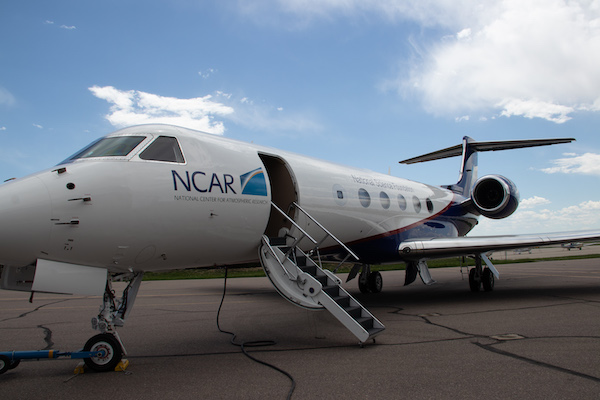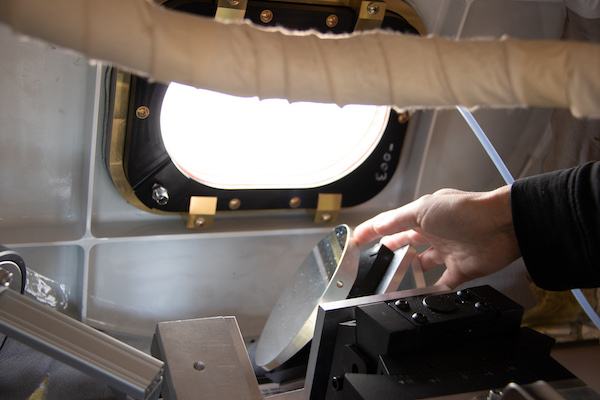Scientists to chase South American total eclipse with research aircraft
Specialized eclipse-viewing instrument to take a second flight
Jun 26, 2019 - by Ali Branscombe
Jun 26, 2019 - by Ali Branscombe

Instrument scientist Jenna Samra kneels next to the Airborne InfraRed Spectrometer (AIR-Spec), an instrument that will be used to view the 2019 South American solar eclipse and measure infrared wavelengths from the Sun's corona. The instrument is mounted on the NSF/NCAR GV research aircraft. (©UCAR. Image: Simmi Sinha)
A scientific instrument specifically designed to study the Great American Eclipse of 2017 will soon be making its second journey through the shadow of the moon. On July 2, scientists from the National Center for Atmospheric Research (NCAR) and the Center for Astrophysics | Harvard & Smithsonian (CfA) will be sending a high-altitude research jet through the path of totality of a solar eclipse, taking place in the Southern Hemisphere, to capture data that could unveil mysteries about the Sun’s magnetic field.
During the flight, scientists on board will be aiming the Airborne InfraRed Spectrometer (AIR-Spec) instrument at the Sun’s corona, which is the outermost part of the solar atmosphere, to measure infrared radiation. The eclipse, caused when the moon passes between the Sun and Earth, offers a brief window to view the corona, which is usually obscured by the bright solar surface. The research aircraft, the NSF/NCAR HIAPER Gulfstream V (GV), is owned by the National Science Foundation and operated by NCAR.

Super-heated, charged particles of plasma hold clues to the Sun’s invisible magnetic fields. “The corona gives us information about the temperature and density of the plasma at the solar surface,” said Edward DeLuca, an astrophysicist at CfA and a principal investigator for the field campaign. “Observing these in the infrared is relatively new and challenging because the Earth’s atmosphere gets in the way.”
Flying along the path of totality as the eclipse makes its way across the South Pacific Ocean will give the researchers eight minutes of total eclipse observing, twice the amount of time of the 2017 eclipse campaign. The aircraft will fly above 40,000 feet, an altitude that puts the AIR-Spec above the clouds and most of the infrared-blocking water vapor in Earth’s atmosphere. While NCAR scientists have a history of observing solar eclipses with ground-based instruments stretching back decades, the 2017 eclipse was the first time the GV was used to chase an eclipse with an instrument on board.
“The benefit of having the GV is the ability to fly above any clouds, and the ability to take full advantage of the eclipse at its longest duration, longer than anywhere on the ground,” said Cory Wolff, who is the NCAR project manager for the field campaign.
A total solar eclipse occurs approximately once every 18 months on Earth, and this year’s eclipse will mainly pass over the South Pacific Ocean. The field campaign, funded by NSF, will be based out of Lima, Peru. Scientists from NCAR and the CfA will accompany the aircraft during the project, and provide educational opportunities for local media and scientists to learn more about the campaign.
Since the 2017 eclipse, the AIR-Spec has undergone two major improvements, said Jenna Samra, the instrument scientist on the project who works at CfA. The instrument has several mirrors that direct the image of the solar eclipse into a telescope, which then focuses onto a spectrometer held in a vacuum chamber. One of these mirrors is steered electronically to compensate for the motion of the aircraft. One improvement to the design is to have this mirror automatically track the edge of the moon, in order to keep the image of the Sun's corona steady as it enters the spectrometer.

“The 2017 image of the Sun was very jittery,” said Samra. “Now we'll be able to have a very stable image.”
The biggest improvement is additional cooling inside the vacuum chamber that contains the spectrometer. Infrared wavelengths are captured as heat, and a cooled instrument is able to better “see” the infrared contrast of the Sun’s corona. Now the corona will appear about 20 times brighter.
The ultimate scientific goal of this field campaign is to better understand the corona’s magnetic field, which cannot easily be measured with an instrument. Like a detective who must reverse-engineer a crime scene, the scientists will focus on five infrared wavelengths as the clues to derive the characteristics of the corona’s magnetic field. “The wavelengths we are seeing in the AIR-Spec could be used as a diagnostic,” said Samra, who did the optical design on the instrument. “In the presence of a magnetic field, the infrared wavelengths will change.”
Scientists have long been interested in better understanding the Sun’s magnetic system, which is responsible for space weather events that can affect technology on Earth. The resulting impact of space weather on Earth can block radio communication, interrupt GPS signals, and even influence the weather.
“An eclipse, seen through the AIR-Spec, offers an opportunity to study the Sun’s atmosphere in a new way,” said Wolff. “We know the eclipse is going to happen, and it is not going to wait for us, so now we have to go out and capture it.”
This material is based upon work supported by the National Center for Atmospheric Research, a major facility sponsored by the National Science Foundation and managed by the University Corporation for Atmospheric Research. Any opinions, findings and conclusions or recommendations expressed in this material do not necessarily reflect the views of the National Science Foundation.